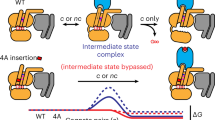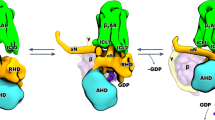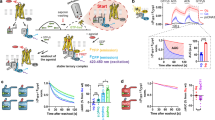Abstract
The mammalian G proteins transduce information from extracellular signals, including neurotransmitters, hormones and sensory stimuli, into regulation of effector enzymes or ion channels within cells. Triggered by appropriate extracellular signals, receptor proteins specifically activate members of the G protein family by catalysing replacement of GDP by GTP at the guanine nucleotide binding site. Like the receptor proteins1, the heterotrimeric G proteins exhibit impressive structural similarities2,3, suggesting that all receptor–G protein interactions use homologous structural elements and a single molecular mechanism. Topologically equivalent portions of each G protein may therefore interact with the appropriate receptor. We recently predicted the secondary structure of a composite G protein α-chain and proposed that a predicted amphipathic α-helix at the extreme carboxy-terminus of the polypeptide directly contacts receptors4. This proposal has now been confirmed by sequencing complementary DNAs of the gene that encodes the α-chain (αs) of the stimulatory regulator (Gs) of adenylyl cyclase in wild-type cells and in a mutant mouse S49 lymphoma cell line, unc, in which Gs cannot be activated by hormone receptors5. The sequences reveal a point mutation in the unc gene that substitutes a proline residue for an arginine near the carboxy-terminus of the αs-polypeptide. Expression of recombinant αs-unc in genetically αs-deficient S49 cells reproduces the unc phenotype.
This is a preview of subscription content, access via your institution
Access options
Subscribe to this journal
Receive 51 print issues and online access
$199.00 per year
only $3.90 per issue
Buy this article
- Purchase on SpringerLink
- Instant access to full article PDF
Prices may be subject to local taxes which are calculated during checkout
Similar content being viewed by others
References
1. Dixon, R. A. F. et al Nature 326, 73-77 (1987). 2. Stryer, L. & Bourne, H. R. A. Rev. Cell Biol. 2, 391-419 (1986). 3. Gilman, A. G. A Rev. Biochem. 56, 615-649 (1987). 4. Masters, S. B., Stroud, R. M. & Bourne, H. R. Protein Engng 1, 47-54 (1986). 5. Haga, T., Ross, E. M., Anderson, H. J. & Gilman, A. G. Proc. natn. Acad. Sci. U.S.A. 74, 2016-2020 (1977). 6. Bourne, H. R., Beiderman, B., Steinberg, F. & Brothers, V. M. Molec. Pharmac. 22, 204-210 (1982). 7. Sternweis, P. C. & Gilman, A. G. J. biol. Chem. 254, 3333-3340 (1979). 8. Schleifer, L. S., Garrison, J. C., Sternweis, P. C., Northup, J. K. & Gilman, A. G. J. biol. Chem. 255, 2641-2644 (1980). 9. Harris, B. A., Robishaw, J. D., Mumby, S. M. & Gilman, A. G. Science 229,1274-1277 (1984). 10. Sullivan, K. A. et al. Proc. natn. Acad. Sci. U.S.A. 83, 6687-6691 (1986). 11. Maniatis, T., Fritsch, E. F. & Sambrook, J. (eds) Molecular Cloning: A Laboratory Manual (Cold Spring Harbor, New York, 1982). 12. Sanger, F., Nicklen, F. & Coulson, A. R. Proc. natn. Acad. Sci. U.S.A. 74, 5463-5467 (1977). 13. Messing, J., Crea, R. & Seeburg, P. Nucleic Acid Res. 9, 309-321 (1981). 14. Jones, D. T. & Reed, R. R. J. biol. Chem., (in the press). 15. Salomon, M. R. & Bourne, H. R. Molec. Pharmac. 19, 109-116 (1981). 16. Maddon, P. J. et al. Cell 42, 93-104 (1985). 17. Miller, A. D., Law, M. F. & Verma, I. M. Molec. Cell Biol. 5, 431-437 (1985). 18. German, C., in DNA Cloning: Vol. II. A Practical Approach (ed. Glover, D. M.) 143-190 (IRL, Oxford, 1985). 19. Mann, R., Mulligan, R. C. & Baltimore, D. Cell 33, 153-159 (1983). 20. Katada, T., Amano, T. & Ui, M. J. biol. Chem. 257, 3739-3746 (1982). 21. Kurose, M., Katada, T., Amano, T. & Ui, M. J. biol. Chem. 258, 4870-4875 (1983). 22. Van Dop, C. et al. J. biol. Chem. 259, 23-26 (1984). 23. Wistow, G. J., Katial, A., Craft, C. & Shinohara, T. FEES Lett. 196, 23-28 (1986). 24. Cerione, R. A. et al. J. biol. Chem. 260, 1493-1500 (1985). 25. Asano, T., Katada, T., Gilman, A. G. & Ross, E. M. J. biol. Chem. 259, 9351-9354 (1984). 26. Cerione, R. A. et al. J. biol. Chem. 261, 3901-3909 (1986).
Author information
Authors and Affiliations
Rights and permissions
About this article
Cite this article
Sullivan, K., Miller, R., Masters, S. et al. Identification of receptor contact site involved in receptor–G protein coupling. Nature 330, 758–760 (1987). https://doi.org/10.1038/330758a0
Received:
Accepted:
Issue Date:
DOI: https://doi.org/10.1038/330758a0
This article is cited by
-
OZITX, a pertussis toxin-like protein for occluding inhibitory G protein signalling including Gαz
Communications Biology (2022)
-
Structures in G proteins important for subtype selective receptor binding and subsequent activation
Communications Biology (2021)
-
Structure and dynamics of GPCR signaling complexes
Nature Structural & Molecular Biology (2018)
-
Heterotrimeric G protein activation by G-protein-coupled receptors
Nature Reviews Molecular Cell Biology (2008)
-
The 2.0 Å crystal structure of a heterotrimeric G protein
Nature (1996)



